Why Winter Is the Best Time to Eat Your Way Through Montreal

When I travel, I seek out those rare moments when I forget I'm far from home — sitting in a restaurant so inviting, I immediately feel like I belong. Perched on a stool at the long wooden bar of a little Montreal restaurant named Le Diplomate, I felt it. Perhaps it was the passion with which chef Aaron Langille described how he spikes butter with Laphroaig. Or maybe it was the joy one of his sous-chefs took in telling me about roasting a whole pig. Or the house-made hoshigaki — an air-dried persimmon that Langille described as "a very elaborate Fruit Roll-Up" — which he cut a piece of and insisted that I taste.
It was a January evening, and I know you would laugh in my wind-whipped face if I told you that Montreal is not that cold in the wintertime. Since I'm not inclined toward public humiliation, let me affirm that Montreal is, in fact, that cold. Walking the streets for hours and hours rekindled my appreciation for long underwear. It also taught me an important lesson about the city in the colder months: it might just be the warmest, loveliest time of year to visit, especially for those who go there to eat.
Montreal is a city bursting with delightful cooking — and these days, it's venturing far from the French-inspired cuisine of the past. Beyond the touristy precincts of Old Montreal, you'll find chefs, mixologists, and bakers who are honoring Quebec's terroir and diversity in new and fascinating ways. Northwest of the city center, a cluster of neighborhoods — Little Italy, Rosemont–La Petite-Patrie, Villeray, Mile-Ex — is emerging as the epicenter of a food culture that cannot be defined by one nation of origin or cooking style.
These communities have welcomed generations of immigrants from around the world. "This is the Montreal of Montrealers. It's scrappier. It's eclectic. We have more freedom to experiment," said Langille, who was born in Alberta, grew up in California, and cooked at Noma before opening Le Diplomate in Mile-Ex.
What's even better for visitors: in the autumn and winter, restaurants are less crowded, and reservations are easier to secure. Chefs committed to regional sourcing deploy remarkable ingenuity at a time when the abundance of summer is a distant memory.
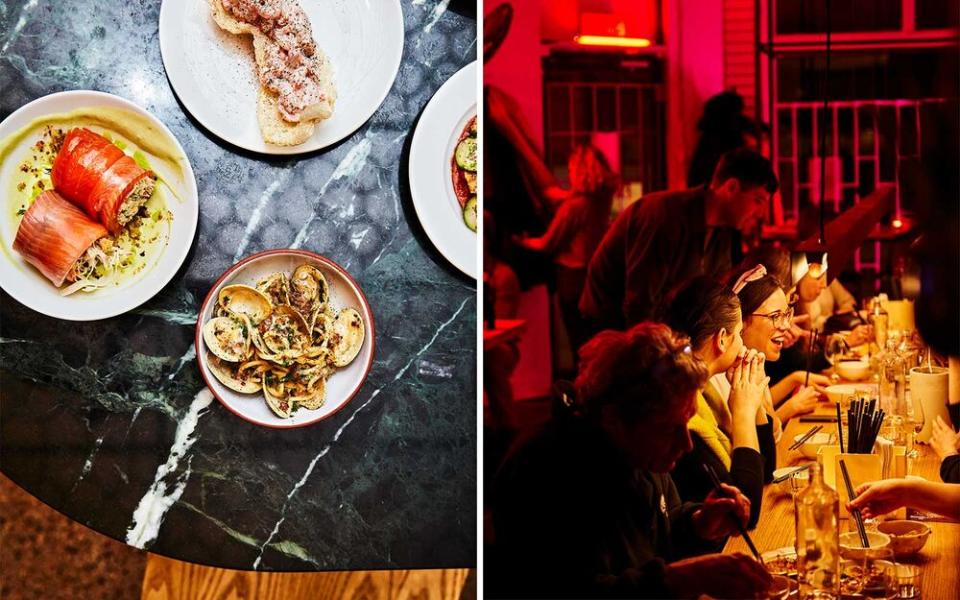
"People here don't give a f**k if it's cold," Marc-Olivier Frappier told me as I sat at the kitchen bar of Vin Mon Lapin, the laid-back, two-year-old eatery in Little Italy that he runs and co-owns. "Last week, there was a snowstorm. It was cold, and it was dark, and they were here."
Vin Mon Lapin has a notable pedigree. Frappier's business partners also run Joe Beef, which has become one of Canada's best-known restaurants thanks to an indulgent menu heavy on foie gras, hulking cuts of steak, and its signature dish, lobster spaghetti. Its spirit of bro-friendly excess had significant consequences; a New Yorker story this past spring documented the testosterone-fueled, alcohol-soaked culture of Joe Beef's kitchen and its leaders' recent attempts to make amends for the toxic work environment they'd created. Yet for all the restaurant's fame and infamy, neither Joe Beef's menu nor its culture seem representative of Montreal's food scene more broadly.
Vin Mon Lapin is an antidote to Joe Beef in multiple ways. Its open kitchen feels cheery, even serene. The menu impresses not with bulk or bravado but with clever comforts, imaginative combinations, and unexpected flourishes. Even something as seemingly quotidian as a bread-and-butter course is reimagined: here, the (excellent) house-made bread comes with margarine. But this isn't the stuff of supermarket notoriety. If there were such a thing as luxury margarine, it would be Vin Mon Lapin's — it's whipped from organic, cold-pressed, locally-made sunflower oil into a spread that is at once light and rich, ethereal and substantial.
As my meal came to an end, I readied myself to go back out into the cold. Frappier asked me to wait, because there was "just a small thing" I had to try before I left. It arrived moments later — a little nest of glistening noodles flecked with something I couldn't immediately identify. You have to love a restaurant where "just a small thing" ends up being a dish of eel carbonara. The eel, smoked during late summer and early fall and then saved for winter, sings of Canadian heritage (First Nations peoples have fished it for millennia), and the carbonara is a loving shout-out to the restaurant's neighborhood. Vin Mon Lapin sits in the heart of Little Italy, which celebrated its centenary this year.
Related: The One Montreal Street Every Food Lover Should Visit
While the Italian-Canadian community had been growing in this area since the late 19th century, 1919 marked a milestone: the construction of the beautiful Church of the Madonna della Difesa signaled that they were here to stay. In 1933, the city opened the Marché Jean-Talon on Little Italy's northwestern edge. It remains one of the biggest open-air markets in North America. The outdoor sections clear out in cold season, but you can still pop into Fromagerie Hamel, which has a phenomenal selection of cheeses, and Le Marché des Saveurs du Québec, which stocks maple syrups from dozens of producers as well as ciders, beers, charcuterie, and other gourmet souvenirs from across the province.
The surrounding streets are dense with shops that have endured for decades. The quirkiest may be Quincaillerie Dante. In 1956, Teresa and Luigi Vendittelli opened this hardware store at the corner of Rue Dante and Rue St.-Dominique to sell Italian-made tools and housewares. A few years later, their sons added guns and ammo for hunters. A few years after that, their daughters transformed the hardware department into one of Montreal's finest kitchen-supply stores. Today the shop is an oddball hybrid, that rare place where you can buy everything you need to both kill an animal and turn it into a meal.
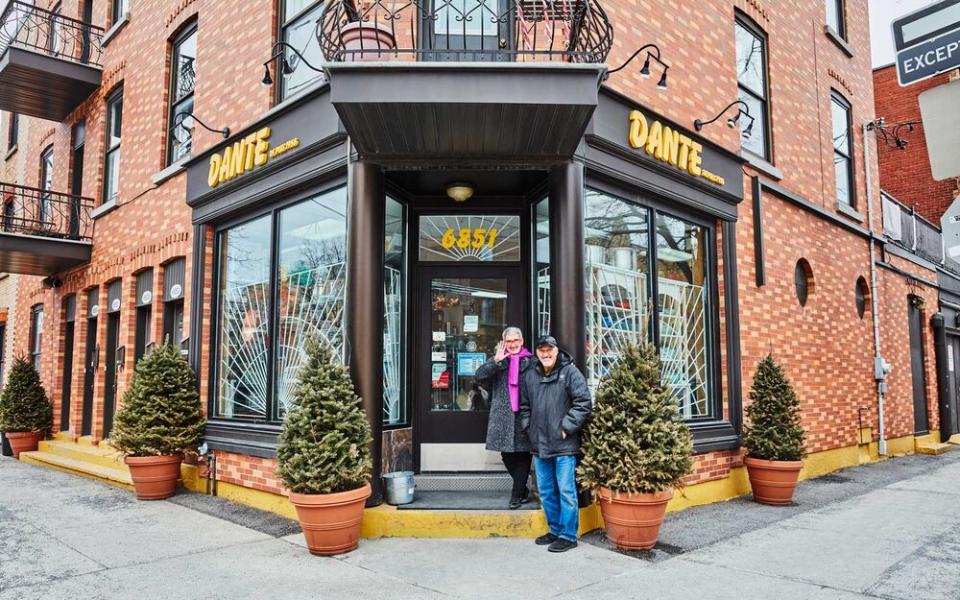
Quincaillerie Dante's place at the intersection of hunting and cooking unwittingly foreshadowed the contemporary obsession with the provenance of our food. You can find that embodied in a particularly compelling way at Manitoba, just past Boulevard St.-Laurent, which forms the border between Little Italy and Mile-Ex. The cooking coming out of chef Simon Mathys's kitchen has nothing to do with the central Canadian province that shares its name. Really, it would more aptly be called Quebec. Mathys is relentless in his passion for Québécois produce. You will not find lemons or chocolate on the menu. Instead, there will be honeyberry and elderberry, whelks and sea truffle. In the wintertime, almost nothing green appears on the plate, "because there's nothing green outside," he said. "We have to find a new way with the turnip or the rutabaga."
Winter's beauty is easily underestimated, underrated, even unseen. It's the sunlight glinting off the icicles hanging from the wrought-iron balconies of Little Italy. It's the snowy filigree on the trees of Jarry Park, where you can skate on a frozen pond. It's the warmth that embraces you as you pass through the doors into a Métro station.
As Mathys said, you have to discover a new way, but one that honors heritage and tradition. Part of that means acknowledging the makeup of modern-day Montreal — only 60 percent of the city's population is of European descent. Montreal has robust Arab, Chinese, Vietnamese, Haitian, and Latino minorities, and everywhere I went, I heard stories of diversity. This is not to say that the rising generation of chefs and restaurateurs has forsaken Montreal's deep roots in French cuisine. Many of them trained in the city's most storied kitchens — not just at Joe Beef but also Toqué, Au Pied de Cochon, and Les 400 Coups, which together helped establish Montreal as a creative culinary destination. The technical rigor shows in their cooking, but in their new environs, they make more room to play.
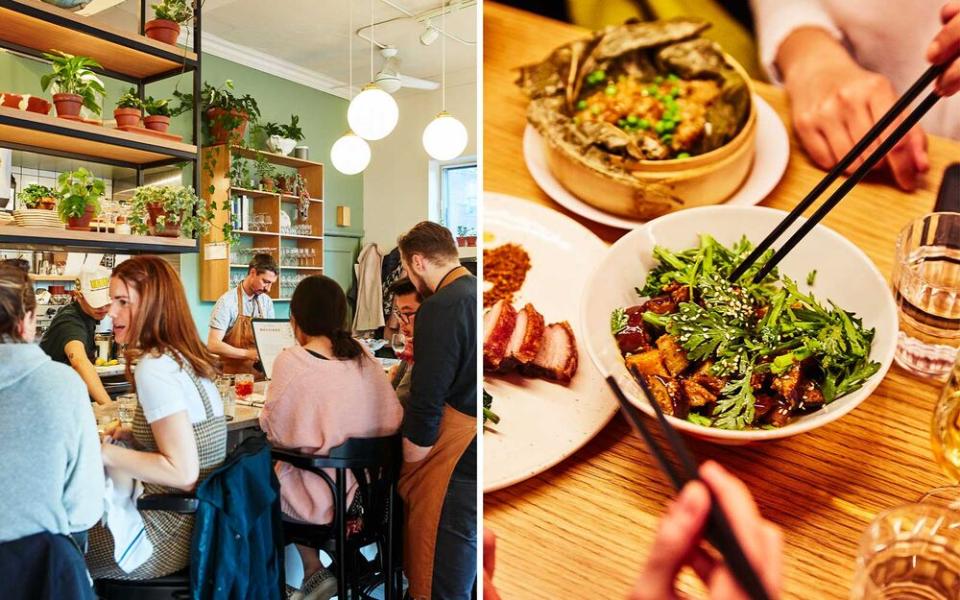
Luca Cianciulli, chef and co-owner of the Italianish restaurant Moccione, in Villeray, embodies both that spirit of playfulness and the drive to do right by his neighbors. He noted that he can see his restaurant from his apartment window — a proximity that reminds him daily of his purpose. "We have the technique and work ethic of a fine-dining restaurant, he said, "and the spirit of cowboys."
You can sense his swagger. Moccione is Italian slang that basically means "sh*thead." He puts pasta on the menu alongside less conventionally Italian dishes, such as a duck tartare ("the parmigiano crisp gives it an Italian twist") and a tempura-light bounty of fried seafood — smelt, calamari, Québécois shrimp — sprinkled with furikake ("not classically Italian, but they're all things you can find in Italy").
Related: How to Love Montreal — Even in Winter
I must have arched an eyebrow, because Cianciulli quickly nodded at the Korean-Canadian colleague alongside him, as if to justify the presence of Asian flavors in his dishes. The way Western chefs blur the borders of Asian cuisines can feel like kitchen colonialism — a new wave of mercantilists sweeping through, taking an idea from here and a spice from there. Yet everything I tasted at Moccione was delicious. And I adored the bargain lunchtime plate of roast pork and Chinese greens over rice I had at the sort-of-Vietnamese eatery Denise, a homey oasis on an industrial street in the Parc-Ex neighborhood. Perhaps, I thought, this culinary mishmash authentically reflects the faces — and indeed, the palates — of modern Montreal.
Two blocks from the Marché Jean-Talon, Emily Homsy and David Gauthier, both formerly of Au Pied de Cochon, have opened Bar St.-Denis. There you can taste Homsy's Egyptian heritage, including a version of her grandmother's falafel, which is made with fava beans.
Homsy and Gauthier insist that their place is a "bar with snacks," not a restaurant. They are equally insistent that they're cooking for their neighbors — "we want people to be able to come here five nights a week," Homsy said. And they're cooking from their neighbors; "our sturgeon comes from the St. Lawrence River," she said. "We know the sturgeon guy. His name is Jamie."
When I told Homsy that I had walked two miles to get to Bar St.-Denis, she looked at me like I was crazy. Then I told her I was planning to walk another two miles to dinner. "You have to have a shot!" she said, running behind the bar to pour glasses of Chartreuse. "It warms you up."
Each of these places made me feel I was lucky enough to step into a real community, to get a taste of someone's home. Likewise with the one place I found myself revisiting compulsively. Automne isn't much to look at. It sits on the ground floor of a generic apartment building in La Petite-Patrie. The windows are often fogged up in the colder months, but BOULANGERIE is neatly printed above the front door. Stand outside for a few minutes and you'll see a stream of locals — an old lady leaning on a cane, a bearded dad pushing a stroller — coming out, fresh loaves in hand.
Chef Seth Gabrielse and baker Julien Roy opened Automne in October 2016. They were struck by the fact that, in bakeries here, "the idea of terroir didn't exist," as Gabrielse put it, and set out to change that. Ninety-five percent of their flours come from Quebec. Most of what does not is rice flour, which they need to make their gorgeous viennoiserie. (Automne's croissant, with its shatteringly crisp exterior and chewy interior, is the best I've had outside France.)
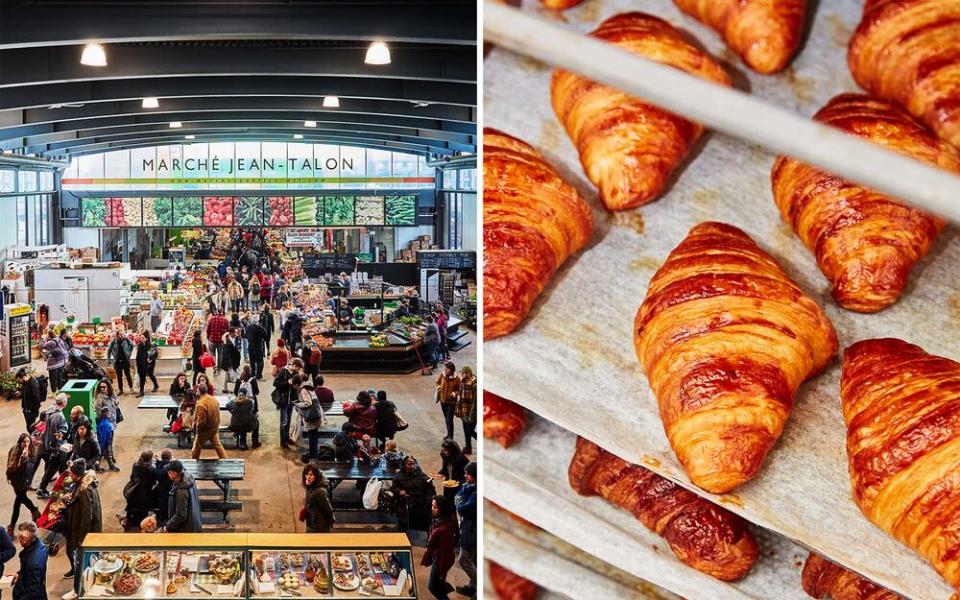
On any given day, there will be more than a dozen loaves on offer. The miche, made with four different flours, is a particularly worthy staple. Sometimes you might find a blueberry-walnut loaf or, in the fall, one made with parsnip. The most expensive is never much more than $4. "I never want to hear about our price," said Roy, whose background is in finance. "I want people talking about our quality."
On my last night in Montreal, I trudged along icy sidewalks to Maison Publique. It's technically in the Plateau, a neighborhood closer to downtown that's more familiar to tourists. But multiple locals had recommended it. When Maison Publique opened seven years ago, on the less-favored residential side of the neighborhood, they said, it pioneered the kind of cooking and hospitality I sought.
The gastropub's warmth instantly clouded my glasses. After I wiped them clean, I could see small glass bottles on each table containing little leaves of chard. Through the pass, I spotted the top of a young boy's head. It was chef-owner Derek Dammann's son, Felix, helping season dishes before they went out to diners.
That set the tone for the whole meal. The food was approachable yet beautifully bold: a single baked oyster with Marmite; foie gras served with buttery madeleines, for extra richness, and apples, for necessary freshness. The standout? A salad of charred squid accompanied by sea urchin emulsified with mustard. It was a glorious puzzle. How could a plate that was cold — or at least not hot — be so warming?
Partway through dinner, the lights went out. As if this happened regularly (it doesn't), the chefs didn't even pause. They whipped out their iPhones and turned on the flashlights, illuminating the kitchen just enough to keep cooking. More candles appeared. A few minutes later, a strobe effect broke through the condensation-covered windows as the flashing red lights of a passing fire truck glowed into the space. The electrical grid was struggling in the cold, and a nearby transformer had exploded.
"C'est l'apocalypse!" one cook said cheerily to a regular. On reflection, that word seemed appropriate, for this meal and for the experience of eating one's way through Montreal in winter. Its earliest Greek form, apokalypsis, signals not disaster but an uncovering, an unveiling, a revelation.
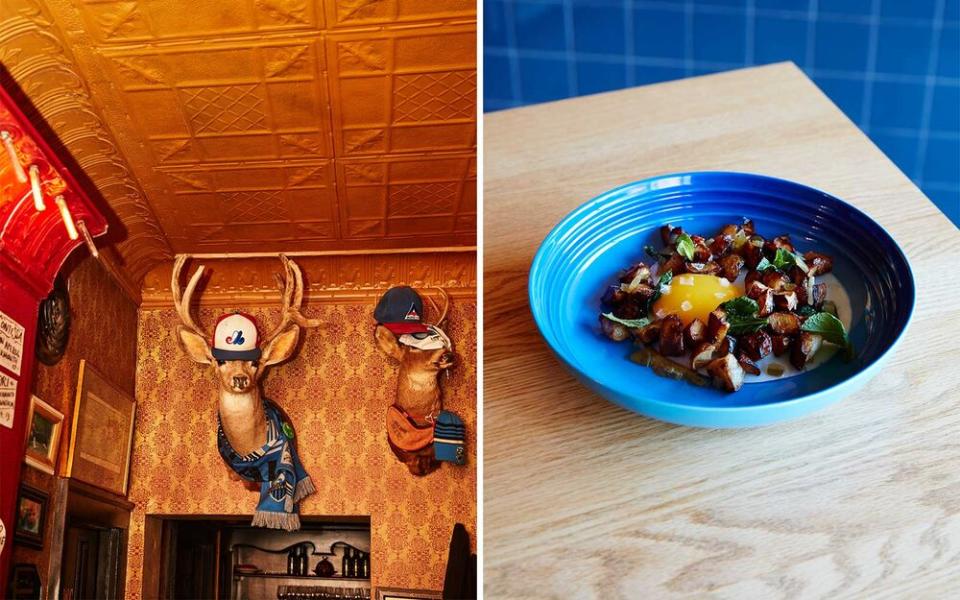
Montreal, Meal by Meal
Where to Eat
Go to Bar St.-Denis in Little Italy for drinks and Middle Eastern–inflected small plates. Nearby Vin Mon Lapin has inventive cuisine and an offbeat yet elegant wine list, while Moccione is the place to go for some of the city’s best Italian. In Parc-Ex, the loosely Vietnamese, all-day café Denise is a must. Maison Publique serves gastropub fare and Canadian wines. Le Diplomate lives up to its name with influences as far-ranging as Korea and Denmark. Manitoba coaxes magic out of Québécois products. Stop by Automne for incredible croissants and breads.
Where to Shop
Visit Marché Jean-Talon for cheeses and pantry items, Épicerie Conserva for Canadian groceries, and Quincaillerie Dante for cookware.
Where to Stay
After 107 years, the Ritz-Carlton still wows — book a suite and cozy up in front of the fire.
A version of this story first appeared in the November 2019 issue of Travel + Leisure under the headline A Very Warm Welcome.

